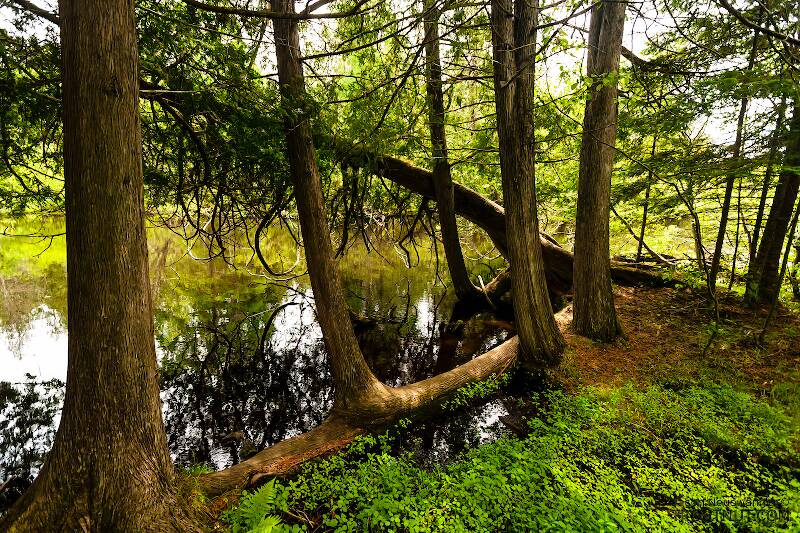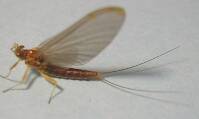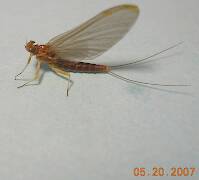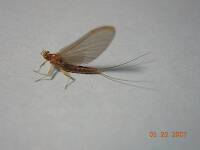
Hex Mayflies
Hexagenia limbata
The famous nocturnal Hex hatch of the Midwest (and a few other lucky locations) stirs to the surface mythically large brown trout that only touch streamers for the rest of the year.
Featured on the forum


Troutnut is a project started in 2003 by salmonid ecologist Jason "Troutnut" Neuswanger to help anglers and
fly tyers unabashedly embrace the entomological side of the sport. Learn more about Troutnut or
support the project for an enhanced experience here.
Martinlf on Apr 3, 2009April 3rd, 2009, 3:15 pm EDT
Those familiar with the last fly swap know I'm keen on Harrop style transitional emergers, the ones that are half nymph and half dun. Gonzo has a particularly elegant take on this that he ties on a swimming nymph hook. Mine is more down and dirty, using a Biot for the nymph part and a Gamakatsu vertical emerger hook. But it's been working on some pretty worked-over and selective fish lately in the BWO version. Now I want to tie some BQ emergers.
My question is, "Does anyone know what a hatching Blue Quill looks like generally?" What I'm finding confusing as I try to come up with a color scheme for the nymph part is that the nymphs are supposed to be light, like a hare's ear, but the dun is dark brown. I know colors vary by stream and by the individual bug, but I'd love to see a couple of photos of hatching BQ's if anyone knows where such might be viewed.
I just went and looked at Gonzo's shucking BQ and he uses brown antron, but his shuck is semi-translucent, suggesting a stage just after what I'm looking to tie.
Gonzo, if they made swimming nymph hooks small enough how would you tie the nymph portion of the transitional fly? Does the nymph darken just before hatching, as (at least so I've been told) olive nymphs tend to?
Anyone else I can bug with these questions?
My question is, "Does anyone know what a hatching Blue Quill looks like generally?" What I'm finding confusing as I try to come up with a color scheme for the nymph part is that the nymphs are supposed to be light, like a hare's ear, but the dun is dark brown. I know colors vary by stream and by the individual bug, but I'd love to see a couple of photos of hatching BQ's if anyone knows where such might be viewed.
I just went and looked at Gonzo's shucking BQ and he uses brown antron, but his shuck is semi-translucent, suggesting a stage just after what I'm looking to tie.
Gonzo, if they made swimming nymph hooks small enough how would you tie the nymph portion of the transitional fly? Does the nymph darken just before hatching, as (at least so I've been told) olive nymphs tend to?
Anyone else I can bug with these questions?
"He spread them a yard and a half. 'And every one that got away is this big.'"
--Fred Chappell
--Fred Chappell
LittleJ on Apr 3, 2009April 3rd, 2009, 3:32 pm EDT
louis, I don't know if i'm much help since I have never seen a hatching B.Q. nymph, But this what has been working for me as a blue quill nymph.
hook- 18-20
abdomen- black turkey biot
thorax - black guard hairs touch dubbed to look extra buggy
head - 1/16 black or gold tung bead
wingcase- pearl tinsel
I know this is opposite of what you say the nymph color is, and frankly it could be, but the reason I use black is because a guide friend told me he always fishes a black zebra midge during a quill hatch. It could be luck but I won't argue with what's working.
jeff
hook- 18-20
abdomen- black turkey biot
thorax - black guard hairs touch dubbed to look extra buggy
head - 1/16 black or gold tung bead
wingcase- pearl tinsel
I know this is opposite of what you say the nymph color is, and frankly it could be, but the reason I use black is because a guide friend told me he always fishes a black zebra midge during a quill hatch. It could be luck but I won't argue with what's working.
jeff
Troutnut on Apr 4, 2009April 4th, 2009, 6:28 am EDT
Here's one with darkened wingpads close to emergence:
http://www.troutnut.com/specimen/693
Hare's ear seems too light to me.
http://www.troutnut.com/specimen/693
Hare's ear seems too light to me.
Jason Neuswanger, Ph.D.
Troutnut and salmonid ecologist
Troutnut and salmonid ecologist
GONZO on Apr 4, 2009April 4th, 2009, 6:36 am EDT
Louis,
Most of the mature Blue Quill (Paraleptophlebia) nymphs that I've seen range from tannish brown to reddish brown to dark brown (nearly black). P. adoptiva nymphs are often on the lighter end of this range, and many Summer Blue Quills (asst'd Paraleptophlebia species) can be somewhat darker. Many mature nymphs are darker in coloration than immature nymphs, but the most significant darkening is in the wingcases.
I've recently found some "swimming nymph" hooks (Daiichi #1770) that are probably small enough to tie an "upside-down" Blue Quill emerger, but I don't trust the hooking of these when tied USD in the smaller sizes. (It's very difficult to keep the materials from interfering with the gap/point.)
Speaking of bent hooks, I thought you might be interested to know that I was chatting with Paul Weamer yesterday. I'm very anxious to try his "Tru-Form" hooks. They are manufactured with almost exactly the bend in the shank that I used to produce by hand for many of my nymphs and other flies. They could have saved me many broken hooks and other frustrations over the years!
Most of the mature Blue Quill (Paraleptophlebia) nymphs that I've seen range from tannish brown to reddish brown to dark brown (nearly black). P. adoptiva nymphs are often on the lighter end of this range, and many Summer Blue Quills (asst'd Paraleptophlebia species) can be somewhat darker. Many mature nymphs are darker in coloration than immature nymphs, but the most significant darkening is in the wingcases.
I've recently found some "swimming nymph" hooks (Daiichi #1770) that are probably small enough to tie an "upside-down" Blue Quill emerger, but I don't trust the hooking of these when tied USD in the smaller sizes. (It's very difficult to keep the materials from interfering with the gap/point.)
Speaking of bent hooks, I thought you might be interested to know that I was chatting with Paul Weamer yesterday. I'm very anxious to try his "Tru-Form" hooks. They are manufactured with almost exactly the bend in the shank that I used to produce by hand for many of my nymphs and other flies. They could have saved me many broken hooks and other frustrations over the years!
Martinlf on Apr 4, 2009April 4th, 2009, 10:59 am EDT
Jeff,
Thanks for jumping in here. I've been favoring blackish nymphs for much of my general nymphing lately, given their overall appeal. Gonzo does note some BQ nymphs get very dark. I just wonder about the majority of them at a very mature stage as I'll be focusing on fish that are actually taking emergers with this fly. Gonzo will tell me to seine, I fear. But I won't get much of a chance for that as my BQ stream is relatively far away and I'll need to tie the fly ahead for an annual trip.
Gonzo,
Thank you, your reply predictably gives me much more information than I had. I guess what I'm ultimately wondering is, if I'm using a turkey biot to represent the nymph on the lower section of the fly, and dubbing to represent the bulb of the dun's head and thorax emerging right at the head of the fly, which should be darker? With my olive emerger I use a very dark brown or olive biot and Caucci's spectrumized dubbing for the emergent fly. Fish really seem to like it; it's worked on very pressured fish on the Little Lehigh and Spring Creek, in holes where the fish are pounded daily. It must look very much like the real thing, and I've come to believe that the contrast between the biot and the dubbing is one thing that makes it work. But I'm very uncertain about how the coloration of Blue Quills generally at this stage (just breaking out of the nymph). Would you hazard a guess about color for the nymph segment and its shade relative to the emergent dun? I'll probably stick with the Caucci BQ dubbing, which is a dark brown.
Thanks for jumping in here. I've been favoring blackish nymphs for much of my general nymphing lately, given their overall appeal. Gonzo does note some BQ nymphs get very dark. I just wonder about the majority of them at a very mature stage as I'll be focusing on fish that are actually taking emergers with this fly. Gonzo will tell me to seine, I fear. But I won't get much of a chance for that as my BQ stream is relatively far away and I'll need to tie the fly ahead for an annual trip.
Gonzo,
Thank you, your reply predictably gives me much more information than I had. I guess what I'm ultimately wondering is, if I'm using a turkey biot to represent the nymph on the lower section of the fly, and dubbing to represent the bulb of the dun's head and thorax emerging right at the head of the fly, which should be darker? With my olive emerger I use a very dark brown or olive biot and Caucci's spectrumized dubbing for the emergent fly. Fish really seem to like it; it's worked on very pressured fish on the Little Lehigh and Spring Creek, in holes where the fish are pounded daily. It must look very much like the real thing, and I've come to believe that the contrast between the biot and the dubbing is one thing that makes it work. But I'm very uncertain about how the coloration of Blue Quills generally at this stage (just breaking out of the nymph). Would you hazard a guess about color for the nymph segment and its shade relative to the emergent dun? I'll probably stick with the Caucci BQ dubbing, which is a dark brown.
"He spread them a yard and a half. 'And every one that got away is this big.'"
--Fred Chappell
--Fred Chappell
GONZO on Apr 4, 2009April 4th, 2009, 11:10 am EDT
Most all mayflies are lighter when they emerge, Louis. I also think that a bit of contrast between the nymph component and the emerging mayfly component is a good idea. (In other words, I would make the nymph part darker and the dun part lighter.)
Martinlf on Apr 4, 2009April 4th, 2009, 12:02 pm EDT
Gonzo,
Let me know how you like the tru-forms. I've tied on them a little, and like them generally, but wish they had a bit more gap in the smaller sizes (16, 18).
Let me know how you like the tru-forms. I've tied on them a little, and like them generally, but wish they had a bit more gap in the smaller sizes (16, 18).
"He spread them a yard and a half. 'And every one that got away is this big.'"
--Fred Chappell
--Fred Chappell
Quick Reply
Related Discussions
Topic
Replies
Last Reply
4
Dec 22, 2009
by Oldredbarn
by Oldredbarn
9
Apr 29, 2009
by Taxon
by Taxon






